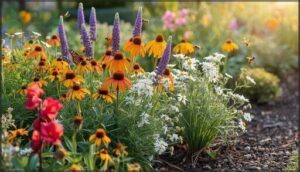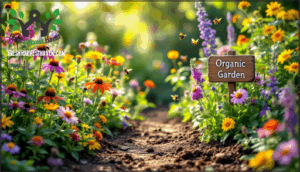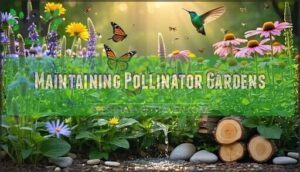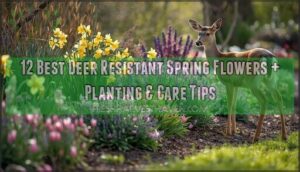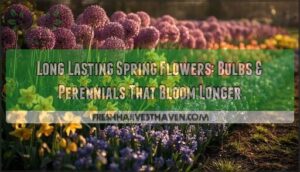This site is supported by our readers. We may earn a commission, at no cost to you, if you purchase through links.
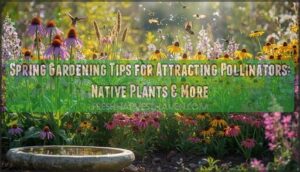
Choose species like purple coneflower, black-eyed Susan, and native milkweed. Plant flowers in clusters rather than single specimens to create visual impact and feeding efficiency.
Avoid pesticides completely, as they harm beneficial insects. Create shallow water sources and leave some bare soil patches for ground-nesting bees.
Mix flower heights and shapes to accommodate different pollinator species, from tiny sweat bees to large bumblebees. The secret lies in understanding which plants bloom when and how specific pollinators navigate your garden landscape.
Table Of Contents
- Key Takeaways
- Creating Pollinator Gardens
- Pollinator Friendly Plants
- Attracting Native Bees
- Sustainable Gardening Practices
- Maintaining Pollinator Gardens
- Frequently Asked Questions (FAQs)
- How do I encourage pollinators in my garden?
- What are three strategies plants use to lure pollinators?
- How to increase the number of pollinators?
- Why aren’t pollinators coming to my garden?
- How do I attract more pollinators to my garden?
- How do I turn my yard into a pollinator garden?
- What time of year should I plant my pollinator garden?
- How do you attract pollinators quickly?
- How do I increase pollination in my garden?
- How often should I water my pollinator garden?
- Conclusion
Key Takeaways
- Choose native plants that bloom sequentially – You’ll create continuous food sources from early spring through fall by selecting species like purple coneflower, black-eyed Susan, and native milkweed that bloom at different times throughout the growing season.
- Plant flowers in clusters and avoid pesticides completely – You’ll maximize visual impact and feeding efficiency by grouping same-species plants together rather than planting single specimens, while skipping all chemicals that harm beneficial insects.
- Create diverse habitats with water and nesting sites – You’ll support different pollinator species by providing shallow water sources with pebbles, leaving bare soil patches for ground-nesting bees, and installing bee hotels 3-5 feet above ground.
- Mix flower heights and shapes for species variety – You’ll accommodate everything from tiny sweat bees to large bumblebees by selecting plants with different bloom structures, including flat, tubular, and clustered flowers that meet diverse pollinator needs.
Creating Pollinator Gardens
Creating pollinator gardens transforms your outdoor space into a thriving ecosystem that supports local wildlife while enhancing your landscape’s beauty.
You’ll want to focus on selecting native plants, ensuring continuous blooms throughout the growing season, and designing spaces that meet the specific needs of different pollinator species, which can help create a thriving ecosystem.
Choosing Native Plants for Pollinators
When choosing native plants for your pollinator garden, you’re investing in local adaptation that benefits both your landscape and regional ecosystems.
Native plants attract bees and butterflies four times more effectively than non-natives, supporting pollinator diversity through specialized relationships developed over thousands of years.
Native plants forge deep connections with local pollinators through thousands of years of co-evolution, creating unmatched ecological partnerships.
Select plant clusters of species that serve as larval hosts for butterflies while providing nectar sources. This strategic approach creates bloom succession that sustains pollinators throughout growing seasons.
In fact, pollinators are essential for global food production.
Planting for Continuous Bloom
If you want your spring gardening efforts to truly support pollinators, focus on Succession Planting and Bloom Diversity for an Extended Season of Nectar Availability.
This keeps your pollinator garden lively and guarantees Pollinator Sustenance.
Try these steps:
- Plant early, mid, and late-blooming pollinator plants.
- Overlap bloom cycles.
- Mix hardy perennials with reseeding annuals.
Selecting Plants for Specific Pollinators
Different pollinators have distinct preferences that’ll transform your garden into a thriving ecosystem.
Bee balm and tubular flowers like salvia attract hummingbirds, while monarch milkweed serves as essential larval hosts for butterflies.
Include night bloomers such as evening primrose for moths.
These targeted pollinator plants create specialized habitats that attract butterflies, bees, and other beneficial visitors to your pollinator garden.
Consider planting vibrant orange butterfly weed for midsummer blooms.
Designing Gardens for Optimal Attraction
Strategic garden layout transforms any space into a pollinator paradise that buzzes with life year-round.
- Color palettes should feature vibrant blues, purples, and yellows that bees see best
- Vertical space maximizes habitat variety with climbing vines and tiered plantings
- Water features like shallow dishes with pebbles create essential drinking stations
- Habitat variety includes sunny spots for butterflies and shaded areas for ground-nesting bees
- Garden design groups same-species plants in clusters of three or more for maximum visual impact.
Many gardeners also find pollinator garden supplies useful for their projects.
Pollinator Friendly Plants
Choosing the right plants transforms your spring garden into a pollinator paradise that buzzes with life all season long.
You’ll want to focus on native species that bloom at different times, ensuring your garden provides continuous food sources from early spring through late fall, creating a paradise.
Native Flowers for Spring Gardens
Early bloomers like crocus and Virginia bluebells kick-start your spring gardening efforts, providing vital spring nectar when hungry bees emerge from winter hideouts.
These native flowers showcase perfect local adaptation, thriving in regional soil conditions while supporting specialist pollinators.
Plant native bulbs such as bloodroot and trout lily alongside wildflower mixes containing wild columbine and hepatica.
Your pollinator garden becomes a beacon for bees, butterflies, and beneficial insects seeking reliable spring flowers that deliver high-quality pollen and nectar during this critical seasonal shift period.
Vegetables and Herbs for Pollinators
Your edible pollinator garden can feed both your family and local pollinators.
Create gardens that nourish both your table and neighborhood pollinators.
Pollinator-attracting herbs like basil, oregano, and lavender provide herb nectar sources when allowed to flower.
Vegetables for pollinators include squash, cucumber, and bean blossoms that attract bees during their vegetable bloom times.
Companion planting herbs like dill and fennel near tomatoes creates companion planting benefits while supporting beneficial insects throughout your garden space.
Many herbs also offer natural pest control, reducing the need for harmful chemicals.
Recommended Plants for Maryland Gardens
Maryland natives thrive when you match soil types and sun exposure to each plant’s needs.
Black-eyed Susans love full sun and well-draining soil, while foamflower prefers shaded woodland conditions.
Create stunning plant pairings by combining cardinal flower’s bright red blooms with goldenrod’s golden clusters.
Mix bloom times strategically—pair spring-blooming bluebells with summer purple coneflowers and fall New York ironweed.
These bee-friendly plants establish your pollinator garden as a year-round haven for pollinators.
Incorporating Milkweed for Monarchs
Every milkweed variety you plant becomes a lifeline for monarch butterflies. These host plants support the complete monarch lifecycle, from egg to adult.
Toxic milkweed compounds protect caterpillars from predators while providing essential nutrition. Milkweed propagation through seeds or division expands your pollinator garden impact.
Essential milkweed varieties for your butterfly-friendly plants:
- Common milkweed – Hardy perennial spreading naturally through underground roots
- Swamp milkweed – Thrives in moist soils with pink flower clusters
- Butterfly weed – Drought-tolerant with bright orange blooms attracting multiple species
- Companion planting with native grasses creates diverse milkweed varieties habitat
Attracting Native Bees
Native bees are powerhouse pollinators that work harder and more efficiently than honeybees, making them essential partners for your spring garden’s success.
Creating the right environment with proper nesting sites, native flowers, and chemical-free practices will transform your yard into a thriving habitat that supports these incredible insects year-round, making them essential partners.
Importance of Native Bees in Pollination
Native bees aren’t just backup pollinators—they’re often more efficient than honeybees.
With over 4,000 species across North America, bee diversity creates specialized pollination relationships that boost crop yields and wild plant reproduction.
Solitary bees like mason and leafcutter bees work independently, visiting more flowers per minute.
Their economic value reaches billions annually, yet native bee decline threatens food security.
Supporting these pollinators through spring planting guarantees robust ecosystems.
| Native Bee Type | Pollination Efficiency | Best Plants |
|---|---|---|
| Mason Bees | 300x more efficient than honeybees for fruit trees | Apple, cherry, plum |
| Leafcutter Bees | Excellent for legumes and wildflowers | Alfalfa, sunflowers, native asters |
| Sweat Bees | Generalist pollinators, very active | Coneflowers, black-eyed Susans |
| Bumble Bees | Buzz pollination for tomatoes | Native bee balm, wild bergamot |
Installing Native Bee Hotels
Creating a successful bee hotel requires attention to design, placement, and maintenance.
Position your bee hotel 3-5 feet above ground facing southeast for morning warmth. Use bamboo tubes or drilled hardwood blocks with 4-8 inch tunnels in varying diameters.
Install mesh screens and roof overhangs to protect against predators and weather. Replace nesting materials annually to prevent pest buildup and maintain healthy pollinator habitat.
Consider planting herbs, as they provide essential nectar sources.
Planting Flowers for Native Bees
Creating the right flower buffet for native bees starts with understanding their diverse needs. Native bees thrive on bee-friendly blooms that offer varied flower shapes and abundant pollen sources.
You’ll want to focus on bloom diversity throughout the growing season to support different native bee diets. Here are key considerations for selecting bee-friendly plants:
- Choose flowers with different shapes – flat, tubular, and clustered blooms
- Plant native species that co-evolved with local bee populations
- Guarantee overlapping bloom times from spring through fall
- Select single-flowered varieties over double blooms for easier pollen access
- Group similar plants together to create visible pollinator attractants
Your spring gardening tips should emphasize native plant selection. Mix early bloomers like wild columbine with mid-season favorites such as bee balm. This approach creates sustainable pollinator-friendly plants that require less maintenance while providing ideal nutrition.
Flower Bee Type Bloom Season
Avoiding Chemical Pesticides
Skip pesticides and herbicides—they harm native bees and soil health.
Natural predators like ladybugs control aphids effectively. Organic alternatives include targeted sprays with soap or neem oil.
Integrated pest management balances garden needs with bee safety. Apply organic pesticides during early morning or evening when bees aren’t active.
Neonicotinoids particularly threaten pollinators, so choose natural pest control methods that protect your buzzing garden helpers, and avoid using harmful chemicals to ensure pollinators are safe.
Sustainable Gardening Practices
Creating a pollinator-friendly garden means more than just planting the right flowers—you’ll need to protect these beneficial insects from harmful chemicals that can disrupt their health and reproduction cycles.
By adopting sustainable practices like organic pest control, companion planting, and composting, you’ll build a thriving ecosystem that supports pollinators while reducing your garden’s environmental impact, which is a key factor in maintaining a healthy ecosystem.
Reducing Chemical Pesticides and Fertilizers
Chemical pesticides and herbicides pose serious threats to pollinators and soil health.
Making the switch to safer alternatives protects beneficial insects while maintaining productive gardens.
Here are five key strategies for reducing chemical inputs:
- Use organic fertilizers like compost and fish emulsion to nourish plants naturally
- Practice companion planting with pest-repelling herbs like basil and marigolds
- Introduce beneficial insects such as ladybugs and lacewings for natural pest control
- Apply organic pesticides like neem oil only when necessary, avoiding neonicotinoids completely
- Build soil health with organic matter to strengthen plant immunity against pests
This approach creates thriving ecosystems where pollinators flourish.
To further improve soil conditions, consider incorporating organic matter into your gardening practices.
Exploring Safer Pest Control Alternatives
You can protect pollinators while managing pests through safer alternatives.
Natural predators like ladybugs and parasitic wasps handle aphids and caterpillars effectively. These methods work better than harsh pesticides:
- Apply organic pesticides like neem oil during early morning when bees aren’t active
- Install yellow sticky traps to catch whiteflies without harming beneficial insects
- Use repellent herbs like mint and garlic sprays against soft-bodied pests
- Practice integrated pest management by combining physical barriers with biological controls
For more options, consider exploring various organic solutions.
Companion plants support this natural pest control approach perfectly.
Practicing Companion Planting
Companion planting pairs plants that naturally repel pests and attract predators while supporting pollinator-friendly plants.
Marigolds with tomatoes deter harmful insects, while herbs like basil enhance growth and attract beneficial insects.
These partnerships improve soil health through diverse root systems and maximize yields through natural pest control.
Plant aromatic herbs near vegetables to create living barriers against unwanted visitors while providing nectar for pollinators.
Composting and Reducing Waste
Beyond companion planting, you can transform kitchen scraps into garden gold through composting.
This waste reduction strategy creates organic matter that enriches soil naturally. Here’s the simple approach:
- **Layer green materials (vegetable scraps, grass clippings) with brown materials (dried leaves, paper) in a 3:1 ratio for ideal decomposition.
Your compost becomes natural fertilizers that boost soil health while cutting household waste.
This recycling method produces organic mulch that retains moisture and feeds beneficial microorganisms, creating healthier conditions for pollinators.
Maintaining Pollinator Gardens
Once you’ve established your pollinator garden, maintaining it properly guarantees these beneficial creatures have everything they need year-round.
Your garden’s ongoing success depends on providing consistent shelter, food sources, and safe spaces that support the complete life cycles of bees, butterflies, and other pollinators.
Providing Shelter and Food Sources
Several key elements transform your garden into a thriving pollinator haven.
Water sources like shallow birdbaths with pebbles provide safe drinking spots while nesting sites such as bee hotels house solitary bees.
Create habitat diversity by leaving dead plant stalks and leaf litter for overwintering insects.
Plant larval hosts like milkweed for monarchs alongside diverse bee-friendly plants that offer nectar sources and pollen throughout seasons.
This year-round support system guarantees your pollinator garden sustains beneficial insects from spring emergence through winter shelter needs.
Maintaining Areas With Wildflowers
Wildflower meadows thrive when you balance maintenance with natural growth patterns.
Regular Weed Control prevents aggressive species from choking out native blooms, while strategic Wildflower Watering during dry spells keeps your pollinator garden flourishing.
Smart Meadow Mowing timing makes all the difference:
- Mow sections in late fall after Seed Collection to encourage natural reseeding
- Leave one-third unmowed each year for overwintering beneficial insects
- Cut invasive grasses before they set seed to protect Habitat Diversity
- Create varied heights by mowing different areas at different times
This approach maintains your wildflower meadow’s ecological balance while supporting native plants and pollinators year-round.
Incorporating Beneficial Insects
Your garden thrives when beneficial insects work alongside plants to maintain natural balance. These tiny allies handle pest control while supporting pollination, creating healthier growing conditions for your flowers.
Predator insects like ground beetles patrol soil surfaces, hunting slugs and harmful pests. Ladybugs offer remarkable benefits, consuming up to 50 aphids daily while their larvae devour even more. Lacewings control soft-bodied insects with voracious appetites, earning the nickname "aphid lions."
Parasitic wasps target specific pests without harming beneficial species. Praying mantises eliminate larger garden threats through natural pest management.
Here’s how to attract these helpers:
Plant diverse flowers while maintaining some garden debris for shelter. This approach supports soil health naturally, creating a balanced ecosystem where natural balance is maintained, and pest control is efficient.
Leaving Dead Plant Stalks for Overwintering Insects
Those forgotten dead plant stalks from fall? They’re actually winter shelters for overwintering insects.
Before your garden cleanup, wait until temperatures consistently reach 50°F to protect emerging pollinators. Consider applying mulch for perennials to protect their roots during the colder months.
Here’s why these insect habitats matter for your pollinator garden:
- Native bees nest in hollow stems throughout winter
- Butterfly chrysalids attach to stalks for spring emergence
- Beneficial predators shelter in plant debris
- Natural ecosystems depend on undisturbed wildlife garden spaces
Frequently Asked Questions (FAQs)
How do I encourage pollinators in my garden?
Transform your space into a pollinator paradise by planting native flowers like milkweed and bee balm in clusters, providing shallow water sources, and avoiding pesticides completely.
What are three strategies plants use to lure pollinators?
Plants use three main strategies to attract pollinators: they produce bright colors and patterns that catch attention.
They also release sweet fragrances that guide insects from distances, and offer nectar rewards that encourage repeat visits.
How to increase the number of pollinators?
You’ll boost pollinator numbers by planting native flowers in clusters, providing shallow water sources with landing spots, avoiding pesticides completely, and creating diverse bloom schedules from spring through fall.
Why aren’t pollinators coming to my garden?
You’re probably lacking native plants, diverse bloom times, or water sources. Check if you’re using pesticides, have enough sun, or need host plants for butterfly larvae.
How do I attract more pollinators to my garden?
Plant native flowers like milkweed, bee balm, and coneflowers in clusters. Provide shallow water with pebbles for safe drinking. Avoid pesticides completely—they’ll harm the pollinators you’re trying to attract.
How do I turn my yard into a pollinator garden?
Transform your yard into a thriving bee highway by replacing traditional lawn with native wildflowers.
Creating shallow water stations, and establishing clusters of plants that bloom spring through fall for continuous nectar is essential to support the bees throughout the year.
What time of year should I plant my pollinator garden?
You can plant your pollinator garden from early spring through late fall, but spring and fall offer the best conditions for establishment before extreme weather hits.
How do you attract pollinators quickly?
You’ll see results fast by planting clusters of early-blooming native flowers like crocus and primrose, providing shallow water sources, and adding simple bee hotels for immediate habitat.
How do I increase pollination in my garden?
You’ll boost pollination by creating diverse nectar sources with native flowers like bee balm and coneflowers.
Add shallow water dishes with pebbles, avoid pesticides completely, and plant flowers in clusters for maximum pollinator attraction.
How often should I water my pollinator garden?
Water’s gentle embrace nurtures your pollinator haven most effectively when you provide deep, infrequent watering rather than daily sprinkles.
You’ll want to water twice weekly, soaking soil thoroughly to encourage deep root growth in your flowering friends.
Conclusion
Transforming your yard into a buzzing metropolis of pollinators doesn’t happen overnight, but these spring gardening tips for attracting pollinators will set you on the right path.
You’ve learned to select native plants that bloom sequentially, avoid harmful pesticides, and create diverse habitats for various species.
Remember that successful pollinator gardens require patience and consistent maintenance.
Keep adding native flowers, provide water sources, and resist the urge to clean up too thoroughly in fall.
Your efforts will reward you with a thriving ecosystem that supports both wildlife and food production.

